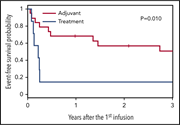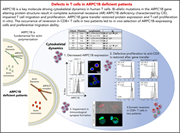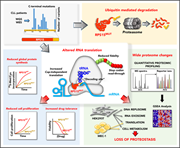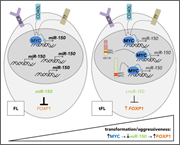Issue Archive
Table of Contents
BLOOD COMMENTARIES
Targeting EBV-positive B- and T/NK-cell lymphomas
Clinical Trials & Observations
In this issue of Blood, McLaughlin et al demonstrate the safety and efficacy of donor-derived Epstein-Barr virus (EBV) latent membrane protein (LMP)-specific T cells to prevent relapse of aggressive EBV-positive B- or T/NK-cell lymphomas following allogeneic hematopoietic stem cell transplantation (HSCT).1
An expanding network of cytoskeletal defects
In this issue of Blood, Brigida et al1 demonstrate that null mutations in ARPC1B result in combined immunodeficiency because of defects in T-cell migration, lymphoproliferation, and formation of the immune synapse, and further show that these abnormalities may be rescued by transduction of wild-type ARPC1B.
Not so lost in translation: RPS15 mutations in CLL
In this issue of Blood, Bretones et al expand knowledge of the functional consequences of recurrent mutations in RPS15, a gene that encodes a ribosomal protein of the 40S subunit and is enriched in patients with clinically aggressive chronic lymphocytic leukemia (CLL).1 By transfecting RPS15 mutants and applying different technologies to assess ribosome activity and efficiency in combination with high-throughput proteome profiling, they were able to demonstrate reduced half-life of RPS15, impaired translational fidelity, and changes in the expressed proteome in mutant vs wild-type RPS15.
PMBCL: a molecular diagnosis?
In this issue of Blood, Mottok et al1 demonstrate the utility of a molecular assay that assesses the expression of 58 genes to distinguish primary mediastinal B-cell lymphoma (PMBCL) from diffuse large B-cell lymphoma (DLBCL) by using routinely available formalin-fixed paraffin-embedded tissue (FFPET) biopsies. The results could improve diagnostic accuracy for patients with PMBCL and may have important implications for clinical trial selection and interpretation of clinical outcomes for patients with this rare form of lymphoma.
Ineffective erythropoiesis of TET2 deficiency
Studies by Qu et al1 in this issue of Blood provide new mechanistic insight into the ineffective erythropoiesis of TET2 deficiency including selective colony-forming unit–erythroid (CFU-E) hyperproliferation, heightened expression of KIT and AXL, and the rescue by KIT and AXL inhibitors of faltered late stage erythropoiesis.
REVIEW ARTICLES
HOW I TREAT
CLINICAL TRIALS AND OBSERVATIONS
EBV/LMP-specific T cells maintain remissions of T- and B-cell EBV lymphomas after allogeneic bone marrow transplantation
Clinical Trials & Observations
There is a Blood Commentary on this article in this issue.
IMMUNOBIOLOGY AND IMMUNOTHERAPY
T-cell defects in patients with ARPC1B germline mutations account for combined immunodeficiency
LYMPHOID NEOPLASIA
Altered patterns of global protein synthesis and translational fidelity in RPS15-mutated chronic lymphocytic leukemia
miR-150 downregulation contributes to the high-grade transformation of follicular lymphoma by upregulating FOXP1 levels
Molecular classification of primary mediastinal large B-cell lymphoma using routinely available tissue specimens
Brief Report
RED CELLS, IRON, AND ERYTHROPOIESIS
TET2 deficiency leads to stem cell factor–dependent clonal expansion of dysfunctional erythroid progenitors
There is a Blood Commentary on this article in this issue.
BLOOD WORK
ERRATA
-
Cover Image
Cover Image
![issue cover]()
Epstein-Barr virus (EBV) latent membrane protein 1 (LMP1) immunostain of a lymph node involved by relapsed Hodgkin lymphoma. Hodgkin/Reed-Sternberg cells are seen in a reactive background of lymphocytes and histiocytes and are EBV negative by EBV-LMP1 after EBV-directed T-cell therapy. See the article by McLaughlin et al on page 2351.
- PDF Icon Front MatterFront Matter
- PDF Icon Table of ContentsTable of Contents
- PDF Icon Back MatterBack Matter
- PDF Icon Editorial BoardEditorial Board
Advertisement intended for health care professionals
Email alerts
Advertisement intended for health care professionals








